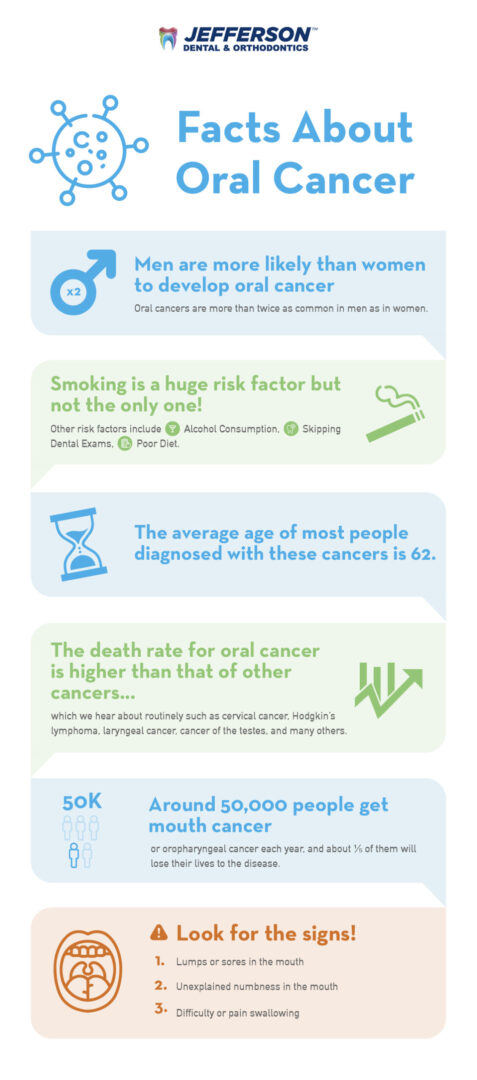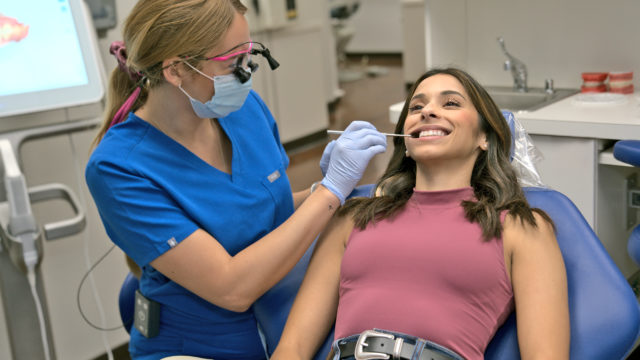We all know the dangers of cancer and you’ve probably heard a lot about cervical cancer, breast cancer, prostate cancer, and lymphoma. Unfortunately for many people, we don’t hear a lot about oral cancer even though the rates are higher than other common types. Let’s take a deeper look at oral cancer, how it presents, and what you can do about it.
What is Oral Cancer?
Oral cancer, also known as mouth cancer or oral cavity cancer, is a silent killer. It’s usually grouped with oropharyngeal (the back of the throat, tonsils and base of the tongue) cancer because they are generally linked and often mean there is cancer in a nearby area, like the voice box or esophagus.
Unfortunately, these types of cancer often go undetected for too long and can easily be mistaken for other conditions. Mouth cancer presents in several different ways and can affect the soft tissues of your mouth, lips, teeth, tongue, or tonsils. Think about all the nooks and crannies that you can’t see in the mirror!
Key Statistics on Oral Cancer in the United States
- Oral cancers are more than twice as common in men as in women.
- The average age of most people diagnosed with these cancers is 62.
- The death rate for oral cancer is higher than that of cancers which we hear about routinely such as cervical cancer, Hodgkin’s lymphoma, laryngeal cancer, cancer of the testes, and many others.
- Around 50,000 people get mouth cancer or oropharyngeal cancer each year, and about ⅕ of them will lose their lives to the disease.

Types of Oral Cancer
As noted, there are several areas in and around your mouth that can develop cancer. It may present differently depending on the area and type of tissue involved.
Lips
Mouth cancer affecting the lips can occur anywhere, but usually presents on the lower lip. It usually looks like a sore and often involves squamous cell carcinoma, meaning it begins in the middle and outer layers of skin.
Gums
When oral cancer appears in the gums, it can be patches on the gums, thickened areas, or cause the gums to crack and bleed. If it’s caught early, gum cancer is highly curable.
Tongue
Tongue cancer is the least common type of oral cancer, but there are two variations. First is oral cancer that affects the part of your tongue that you move around. The other is grouped with oropharyngeal cancer because it occurs at the base of the tongue where it meets your throat.
Both types of tongue cancer usually start as a lump or sore that doesn’t heal. You could develop pain, bleeding, voice changes, and difficulty swallowing.
Cheeks
Formerly known as buccal mucosa, the cheeks and backs of your lips can develop cancer. There are no signs in the early stages of this form of the disease, but as it advances you can develop an array of symptoms ranging from lumps or patches to ear pain and swollen jaw or tongue.
Roof of mouth
The roof of your mouth is also known as the hard palate. It separates your mouth from your nasal cavity, so when cancer develops in the hard palate, it often spreads to the nasal cavity. The most common sign of hard palate cancer is an ulcer.
Floor of mouth
Cancer that begins under your tongue is known as floor of the mouth cancer. It causes pain and sores that won’t heal. Some people notice loose teeth, pain with swallowing, and ear pain.
Throat
Throat cancer can develop in your pharynx, larynx (voice box), epiglottis, or tonsils. It generally presents like oral cancers and can affect your ability to speak and swallow.
What Causes Oral Cancer?
The leading cause of oral and oropharyngeal cancers is heavy tobacco or heavy alcohol use. Since tobacco products contain known carcinogens, using any type, including smokeless tobacco products, can increase your chances of developing oral cancer.
Like other types of cancer, oral or oropharyngeal cancers occur due to a mutation of cell DNA that leads to replication of abnormal cells. The abnormal cells multiply to form a tumor. Most oral cancers are squamous cell carcinomas that form in the middle and outer layers of tissue.
Additional risk factors for mouth cancer include a family history of oral cancer, a weakened immune system, HPV (human papillomavirus), or excessive exposure to the sun without protecting the lips.
Symptoms of Oral Cancer
Each type of mouth cancer can present differently, but there are some commonalities. If you experience any of these symptoms, it’s important to see a medical professional for evaluation. Only a doctor can diagnose oral cancer and formulate an appropriate treatment plan.
- Sores that don’t heal
- White, pinkish-white, or reddish patch inside mouth
- Loose teeth
- Unexplained bleeding in your mouth, gums, or tongue
- Unexplained numbness in or around your mouth or throat
- Persistent sores of the face, neck or mouth that bleed easily and do not heal within 2 weeks
- A growth, that feels like a bump or lump in your mouth
- Unexplained mouth or jaw pain
- Ear pain
- Difficulty swallowing or pain when swallowing
- Dramatic, unexplained weight loss
How is Oral Cancer Treated?
Oral cancer treatment can vary depending on the stage and location of the cancer as well as the patient’s health. And, more than one type of treatment may be necessary to ensure the best possible outcome.
Surgery
Surgical intervention involves removing the tumor or the entire area around the tumor if it spreads into the neck and lymph nodes. Surgery may also be recommended to reconstruct the mouth with grafts and implants to help patients regain function.
Radiation
Radiation therapy involves the use of high-energy beams to destroy cancer cells. It can be used alone in the early stages or in conjunction with surgery in later stages.
Chemotherapy
Chemotherapy uses chemicals to destroy the cancer cells and may be used with other types of treatment, especially radiation, to increase a patient’s prognosis.
Drug Therapy
Targeted drug therapies alter parts of the cancer cells to prevent them from growing. This method can be combined with chemotherapy or radiation therapy.
Immunotherapy
Immunotherapy is generally reserved for advanced cases that don’t respond to other treatments. It involves using your own immune system to fight cancer.
How to Prevent Oral Cancer
Some risk factors for oral cancer can’t be changed. For example, men are twice as likely to develop oral cancer than women and the likelihood rises after the age of 55. However, there are factors that you can control to lower your chances. Lifestyle choices can increase the likelihood of developing cancer of the mouth. Quitting tobacco use, limiting your alcohol intake, avoiding long periods in the sun, and eating a lot of fruits and vegetables are key steps to lower your chances of developing oral cancer.
Performing self-exams regularly is an excellent way to catch mouth cancer early. Self-exams only take a few minutes and can be done as part of your morning or nightly routine.
- Remove any dentures or appliances.
- Feel around the inside of your lips and gums.
- Check the roof of your mouth by tilting your head back slightly.
- Check the insides of your cheeks and back gums by pulling your cheek outward so you have a good view.
- Stick your tongue out and examine all surfaces.
- Feel along your neck and lower jaw for any lumps or enlarged lymph nodes.




